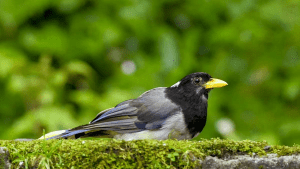TAG: GS 3: ECOLOGY AND ENVIRONMENT
THE CONTEXT: The Himalayas are home to a diverse array of avian species, among them, the striking blue magpies stand out.
EXPLANATION:
- Belonging to the Corvidae family, which includes crows, jays, and ravens, magpies have long captured the fascination of cultures worldwide, often being associated with various omens, both good and bad.
- In European folklore, they are linked with witches and are the subjects of rhymes and superstitions.
- However, beyond their mythical associations, these birds are remarkable for their appearance and behavior, particularly in the Himalayan region.
Magpies:
- Magpie, any of several long-tailed birds belonging to the family Corvidae (order Passeriformes).
- The best-known species, often called the black-billed magpie (Pica pica), is a 45-centimetre (18-inch) black-and-white (i.e., pied) bird, with an iridescent blue-green tail.
- It occurs in northwestern Africa, across Eurasia, and in western North America.
- A bird of farmlands and tree-studded open country, it eats insects, seeds, small vertebrates, the eggs and young of other birds, and fresh carrion.
- It makes a large round nest of twigs cemented with mud.
 Gold-billed magpies
Gold-billed magpies
Distribution and Species
- Blue magpies are prevalent across the Himalayan range, spanning from Kashmir to Myanmar.
- Within this region, several closely related species can be observed, including the gold-billed magpie (Urocissa flavirostris), also known as the yellow-billed blue magpie, the red-billed magpie, and the blue magpie.
- These species exhibit variations in habitat preference and altitude range, with the gold-billed magpie favoring higher altitudes between 2000 and 3000 meters above sea level, while the blue magpie is commonly found at lower altitudes where human settlements are more concentrated.
Habitat and Behaviour
- Trekking Corridors and Biodiversity Hotspots
- The trekking corridors of the Himalayas, such as the route from Yuksom to the Kanchenjunga region in Western Sikkim, offer prime opportunities for observing these magnificent birds.
- These corridors traverse diverse landscapes, ranging from tropical moist broad-leaf forests at lower elevations to treeless Alpine environments at higher altitudes.
- The biodiversity of these areas, as evidenced by studies conducted by zoologists at the Sikkim Government College, is astonishing, with over 250 species of birds documented within the zone.
- The presence of blue magpies, particularly the yellow-billed variety, is a common feature of this avian chorus.
- Nesting Habits and Reproduction
- Blue magpies exhibit distinct nesting behaviors, often constructing nests in the forks of branches in rhododendron trees.
- These nests, though appearing haphazardly built from twigs, provide a safe haven for raising their young.
- Breeding typically occurs in the months of May or June, with both parents actively participating in incubating the eggs and caring for the hatchlings.
- This cooperative effort reflects the nurturing aspect of these birds, as echoed in the rhyme “two for joy.”
Conservation Concerns
- As human activities encroach upon the habitats of Himalayan magpies, concerns regarding their long-term survival arise.
- The allure of the region’s natural beauty, including the vibrant rhododendron flowers, attracts tourists, leading to increased pressure on local ecosystems.
- Villagers, reliant on forest resources for livelihoods, often face dilemmas between conservation and economic needs.
- Sustainable tourism practices, coupled with community-driven conservation efforts, hold promise in mitigating the adverse effects of human presence on magpie populations and their habitats.
SOURCE: https://www.thehindu.com/sci-tech/science/the-magpies-of-the-himalayas/article68161767.ece
Spread the Word
